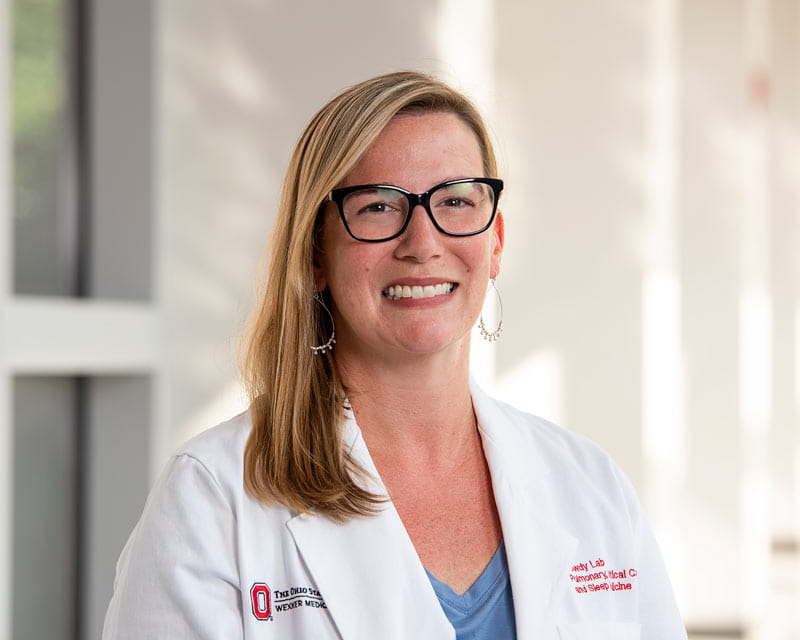
Ohio State Researchers Launch NIH-Funded Study on Ozone-Induced Pulmonary Inflammation
 In 2020, although pulmonologists and other providers at The Ohio State University Wexner Medical Center were stretched thin by the demands of caring for COVID-19 patients, they helped 68 people receive lifesaving lung transplants. This accomplishment would not have been possible without the efforts of the entire lung transplant team, including colleagues in cardiac surgery.
In 2020, although pulmonologists and other providers at The Ohio State University Wexner Medical Center were stretched thin by the demands of caring for COVID-19 patients, they helped 68 people receive lifesaving lung transplants. This accomplishment would not have been possible without the efforts of the entire lung transplant team, including colleagues in cardiac surgery.
The team weathered unprecedented challenges by relying on its robust organ procurement and post-transplant surveillance strategies, which allow the lung transplant program to consistently reduce wait times while maintaining patient and graft survival rates that exceed the national average.
Throughout its more than 20-year history, physicians and researchers in Ohio State’s lung transplant program have been at the forefront of the field. Among other initiatives, they’ve led efforts to increase the number of patients who are eligible for transplant, expand the pool of viable donor lungs and reduce the risks of rejection and other complications following transplantation.
In 2016, the Ohio State Wexner Medical Center was among 17 U.S. institutions chosen to participate in the landmark NOVEL Extension trial. During this study, investigators evaluated the safety and efficacy of ex-vivo lung perfusion (EVLP) as a means of resuscitating (and then re-evaluating) donor lungs of questionable quality prior to transplantation. The technology was approved by the Food and Drug Administration in 2019.
“Thanks to innovations like ELVP, our program routinely takes donor lungs that wouldn’t have been accepted even 10 years ago,” says David R. Nunley, MD, medical director of the lung transplant program. “For example, when we receive offers for lungs that have a low P/F ratio, but the donor is young, we can often perform a transplant after recovering, ventilating and perfusing those lungs. We’ve safely and successfully utilized lungs with a P/F ratio in the 200s or low 300s, as well as lungs from donors with longer-than-ideal smoking histories.”
In cases where team members can’t or won’t use EVLP, they work closely with organ procurement specialists to assess donor lungs in situ, thereby confirming lung quality and function prior to accepting them.
“Our combined efforts allow us to be more aggressive with the offers we’re given, and subsequently our patients get transplanted more quickly,” Dr. Nunley adds. “The most recently reported median wait time for a lung transplant at the medical center was 1 month, which is exceedingly short compared to many other programs.”
Despite stretching the typical boundaries of donor lung recruitment, the Ohio State Wexner Medical Center consistently achieves strong patient outcomes. Data released by the Scientific Registry of Transplant Recipients in July 2021 confirmed the program’s one-year survival rate is 90.71%, which is higher than the national average (89.68%).
“We use a variety of approaches to reduce the risks of rejection and infection among our patients, including induction immunotherapy and rigorous antibiotic prophylaxis,” Dr. Nunley says. “After transplant, we perform scheduled surveillance bronchoscopies with biopsies to screen for rejection, while also monitoring for other types of rejection responses such as antibody-mediated rejection.”
Transplant patients at the Ohio State Wexner Medical Center have access to clinical trials that may provide new insights into graft rejection and transplant candidacy. Studies currently enrolling include:
Dr. Nunley expects research efforts will soon expand to include the impact of COVID-19 on donor lung viability and availability.
“The pandemic has quickly changed the playing field, and we don’t know the full ramifications of coronavirus infection just yet,” he says. “We’ll probably see residual lung damage in many people who had COVID, as well as lung fibrosis that will need to be considered prior to organ procurement and transplantation. But I have no doubt that whatever new challenges get thrown our way, our team will tackle them head-on and find new opportunities to ensure that our transplant patients get a second chance at life.”
To schedule a provider-to-provider introduction or program update with our lung transplant team, please contact Senior Outreach Coordinator Heidi Erb at Heidi.Erb@osumc.edu or 614-685-3013.
Learn more about innovations in care and research from the Division of Pulmonary, Critical Care and Sleep Medicine.